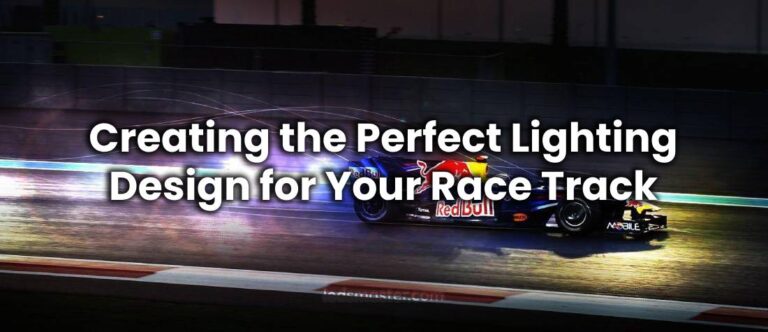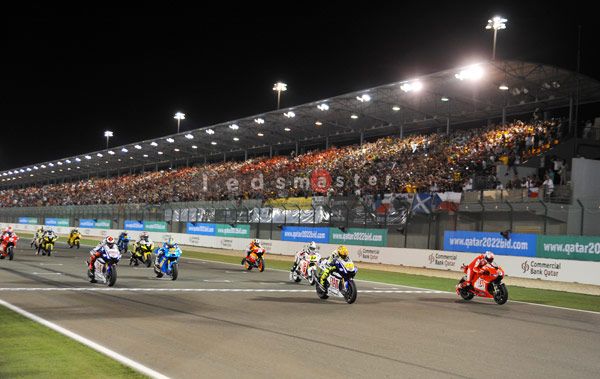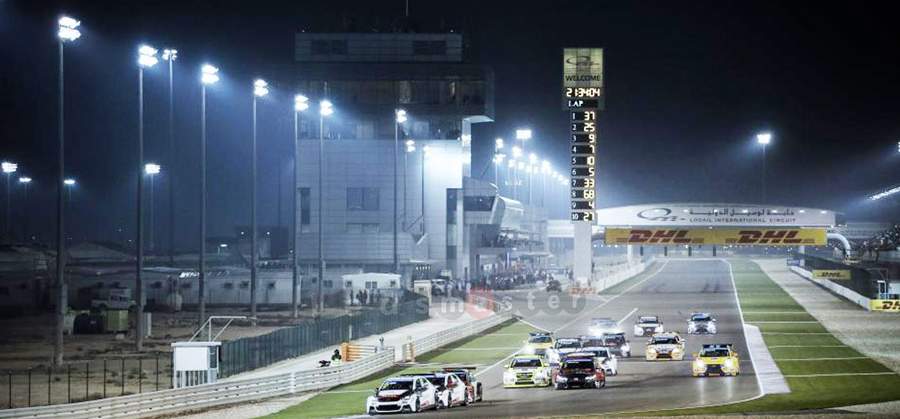
Lighting up a race track isn’t just about brightness; it’s about precision, performance, and safety. As the roar of engines and the thrill of high-speed competition fill the air, the right lighting can make all the difference. LED race track lights are revolutionizing how we illuminate these dynamic venues, offering unmatched durability, energy efficiency, and superior visibility. Dive into the world of LED lighting and discover why it’s the top choice for modern race tracks, ensuring every race is run under optimal conditions.
Get your complimentary lighting design today
Bright and even illumination is vital for the safety of racers and spectators at a race track. LED lighting has emerged as the preferred choice over traditional options like high-pressure sodium (HPS), metal halide, mercury vapor, and halogen flood lamps, thanks to its superior energy efficiency and durability.
Our advanced motor speedway lighting system caters to various events, including recreational races and prestigious international competitions such as NASCAR and the Formula 1 World Championship. Discover how LED technology can elevate race track and arena lighting, enhancing both visibility and safety.
Table of Contents
Toggle When designing lighting for race tracks, achieving the right brightness level is essential for maintaining safety and performance. High-speed racing involves intense focus and quick responses to potential hazards, making adequate illumination crucial. The general standard for race track floodlights is to provide a minimum of 700 to 1000 lux. This level ensures that racers can clearly see the track and react promptly to any changes or obstacles.
When designing lighting for race tracks, achieving the right brightness level is essential for maintaining safety and performance. High-speed racing involves intense focus and quick responses to potential hazards, making adequate illumination crucial. The general standard for race track floodlights is to provide a minimum of 700 to 1000 lux. This level ensures that racers can clearly see the track and react promptly to any changes or obstacles.
The lux requirement can vary depending on the specific demands set by racing associations, such as NYRA. For more advanced and high-profile events, such as those held by NASCAR or the Formula 1 World Championship, the lux levels need to be significantly higher. In such cases, both horizontal and vertical lux levels may need to reach between 1500 and 2000 lux. Horizontal lux measures the brightness on the ground, which is crucial for overall visibility, while vertical lux measures the illumination on the sides of the racing vehicles. Achieving an optimal balance between these two types of lux is vital. The ideal lighting setup maintains a ratio of approximately 1:1 between horizontal and vertical lux, which provides the best overall lighting quality within the racing arena.
Selecting the appropriate luminaries can be complex, given the different factors involved. For example, to illuminate a 1000-square-meter field with a requirement of 800 lux, the total lumen output required is 800,000 lumens. This means that theoretically, at least 6000W of LED lights would be necessary. However, this is a preliminary calculation and actual needs may vary. For a more accurate assessment tailored to specific requirements, consulting with our sales representatives is recommended.
Who We Are
At LedsMaster, we are dedicated to providing high-quality LED sports lighting solutions at competitive prices. Our expertise extends to delivering tailored lighting designs for various applications, including race tracks. We understand the importance of precise and effective lighting in sports venues, and we offer free lighting design consultations to help you achieve the best results for your racing track projects. For more detailed information or to receive a custom lighting design, do not hesitate to reach out to our team.

Beyond achieving the right brightness, ensuring uniform lighting across the race track is another critical aspect. Uniform lighting means that the lux levels are evenly distributed across the entire track, avoiding areas of excessive brightness or dark spots. This even distribution is essential for providing consistent visibility and enhancing the overall experience for both racers and spectators.
Lighting uniformity is typically measured using a ratio, with a uniformity rating of 0.5 to 0.6 generally considered acceptable. However, to provide an enhanced viewing experience and optimal lighting conditions, we offer LED motorsport lighting solutions with uniformity ratings ranging from 0.7 to 0.8. These higher ratings ensure that lux levels are more consistently distributed, minimizing the risk of uneven lighting conditions.
For those new to lighting design, understanding whether a lighting solution is sufficiently bright and uniform can be challenging. In the lighting industry, photometric reports are commonly used to assess lighting performance. Tools such as DIALux and RELUX are widely used by lighting designers and engineers to create these reports. These tools help visualize and analyze lighting distribution and uniformity. We provide free lighting design reports to assist you in evaluating the performance of your lighting solution. Feel free to contact us to receive professional guidance and ensure your lighting design meets all necessary standards.
The Color Rendering Index (CRI) is a measure of how accurately a light source reveals colors compared to natural sunlight. The CRI scale ranges up to 100, with a value of 100 representing the closest match to natural light. High CRI values are essential for accurately representing colors, which is particularly important in sports lighting where color accuracy can affect visibility and performance.
A low CRI, typically below 60, can cause significant color distortion, making it difficult to perceive the true colors of the vehicles and the track environment. To address this, our sports lighting solutions offer high CRI options ranging from 80 to 90. These high CRI values ensure that colors are rendered with high fidelity, providing a more natural and accurate visual experience for both racers and spectators.
In the age of high-definition video and slow-motion photography, flicker-free lighting is essential. Spectators, media professionals, and racing teams often use smartphones and cameras capable of capturing high-speed footage and high-resolution images. To support these advanced imaging requirements, our premium lighting systems are designed to be flicker-free, with performance specifications of up to 6000 Hz and a flicker rate of less than 0.3%.
This flicker-free technology ensures that video recordings and photographs of the race are clear and free from visual artifacts caused by flickering lights. This is particularly important for capturing high-speed moments and detailed visuals of the luxury sports cars in action. By investing in our advanced lighting solutions, you can be confident that your race track will provide optimal conditions for both live spectators and media coverage.

Night racing is a frequent occurrence, and reliable lighting is essential to ensure safety and prevent economic loss. Traditional lighting systems, such as metal halide, mercury vapor, high-pressure sodium (HPS), and fluorescent lamps, are prone to frequent maintenance and shorter lifespans. In contrast, our LED lights boast an impressive lifespan of approximately 80,000 hours at L70, translating to about 22 years of operation when used for 10 hours daily. This long-lasting performance reduces maintenance costs significantly and minimizes the risk of light failure during critical events.
For race tracks hosting continuous events like the 24 Hours of Le Mans or other night races, this durability is particularly crucial. Moreover, our LED lights are designed to be waterproof, making them resilient against adverse weather conditions. This added feature ensures that your lighting system remains operational and reliable, regardless of the weather.
Inefficient lighting systems often result in scattered light beams that leak into surrounding areas, leading to several issues. First, the central brightness of the track diminishes, which can negatively impact lighting quality and necessitate the installation of additional lights to compensate for the loss. Second, this leakage contributes to light pollution, which can disturb nearby residential areas and affect local wildlife.
Our LED lighting systems are meticulously designed to address these concerns. By integrating various lighting powers, beam angles, and lens covers, we focus on minimizing light pollution and directing illumination precisely where it is needed. This approach ensures that the light is concentrated on the race track, enhancing visibility while reducing the impact on the surrounding environment.
The overall cost of race track lighting varies depending on the scale and specifications of the track. For a medium-sized racetrack, the initial investment in LED lamps typically ranges from $25,000 to $60,000. To obtain a more precise estimate tailored to your specific needs, we encourage you to consult with our sales representatives.
In terms of operational costs, LED lighting offers significant savings compared to traditional lighting systems. For instance, running a 10,000W LED lighting system costs approximately $9.60 per day or $288 per month, based on an electricity rate of $0.12 per kWh and an 8-hour daily operation. This is in stark contrast to halogen floodlights, where the operational cost would be around ten times higher for the same brightness level. The efficiency of 10,000W LED lights matches the output of 100,000W halogen lamps, making LEDs a more economical choice in the long run.
Our LED race track lighting solutions incorporate advanced anti-glare technology, designed to enhance the overall lighting experience. This innovative system features precise light control that reduces glare and provides exceptional uniformity, which is crucial for both racers and spectators. The anti-glare capability supports high-definition filming, including 4K and Full HD recordings, ensuring clear and sharp visuals even at night.
By minimizing glare and focusing light accurately, our LED lighting systems not only improve visibility for drivers but also reduce environmental impacts such as light pollution. Whether for drivers, spectators, or photographers, our tailored lighting solutions deliver optimal performance and a superior viewing experience.
One of the most compelling reasons to choose LED lighting for race tracks is its exceptional energy efficiency. LED lights consume significantly less power compared to traditional lighting options, which reduces overall energy consumption and lowers utility bills. This efficiency translates into a smaller carbon footprint, making LED lights an environmentally friendly choice. By reducing energy usage, you contribute to sustainability and help lower greenhouse gas emissions.
Additionally, the long lifespan of LED lights means fewer replacements and less waste. Traditional lighting often requires frequent replacements and generates more waste, whereas LEDs reduce the frequency of maintenance and disposal. This combination of energy efficiency and reduced waste makes LED lighting a responsible and eco-friendly option for modern race tracks.
LED lighting offers unparalleled flexibility in design and application. With the ability to adjust beam angles, light intensities, and coverage areas, LED systems can be customized to meet the specific requirements of any race track. This flexibility allows for precise lighting arrangements that enhance visibility and performance while accommodating various track layouts and configurations.
Whether you need to highlight specific sections of the track, adjust lighting for different events, or modify the setup for various racing conditions, LED lighting systems can be tailored to suit your needs. This adaptability ensures that you get the best possible lighting solution, enhancing both the functionality and aesthetic appeal of your race track.
Incorporating LED lighting into race track design offers numerous advantages that significantly enhance both performance and efficiency. From exceptional durability and reduced maintenance costs to minimizing light pollution and optimizing energy use, LED lights prove to be a superior choice for modern race tracks. Their anti-glare technology ensures clear visibility for drivers and high-quality visual experiences for spectators and media. Additionally, the flexibility in design and the positive environmental impact further underline the benefits of transitioning to LED lighting. By choosing LED solutions, race tracks can achieve superior illumination, cost savings, and sustainability, making them an ideal investment for the future of high-speed racing.